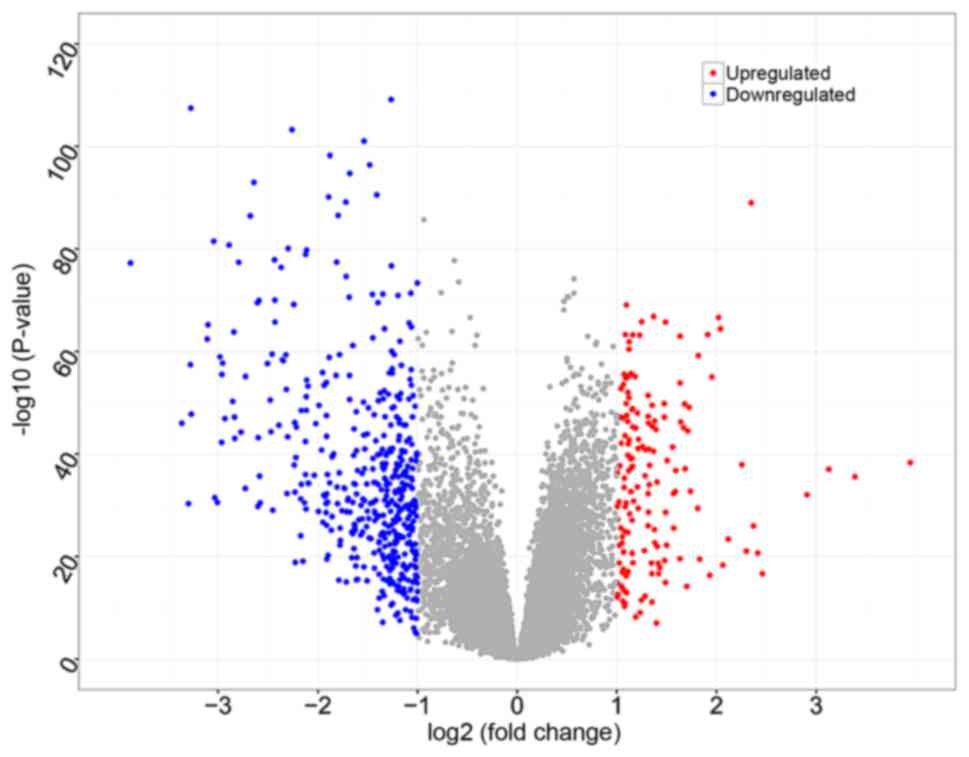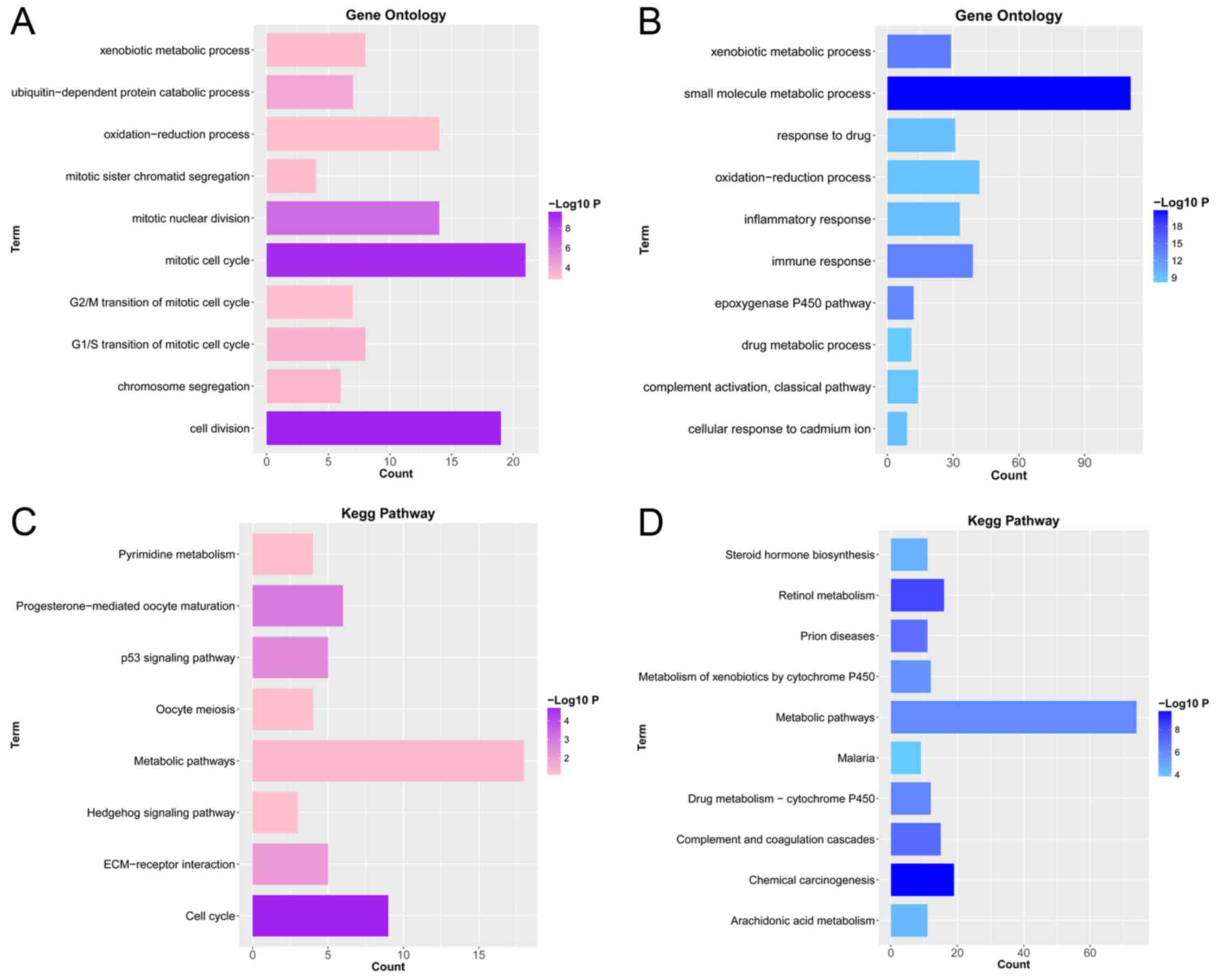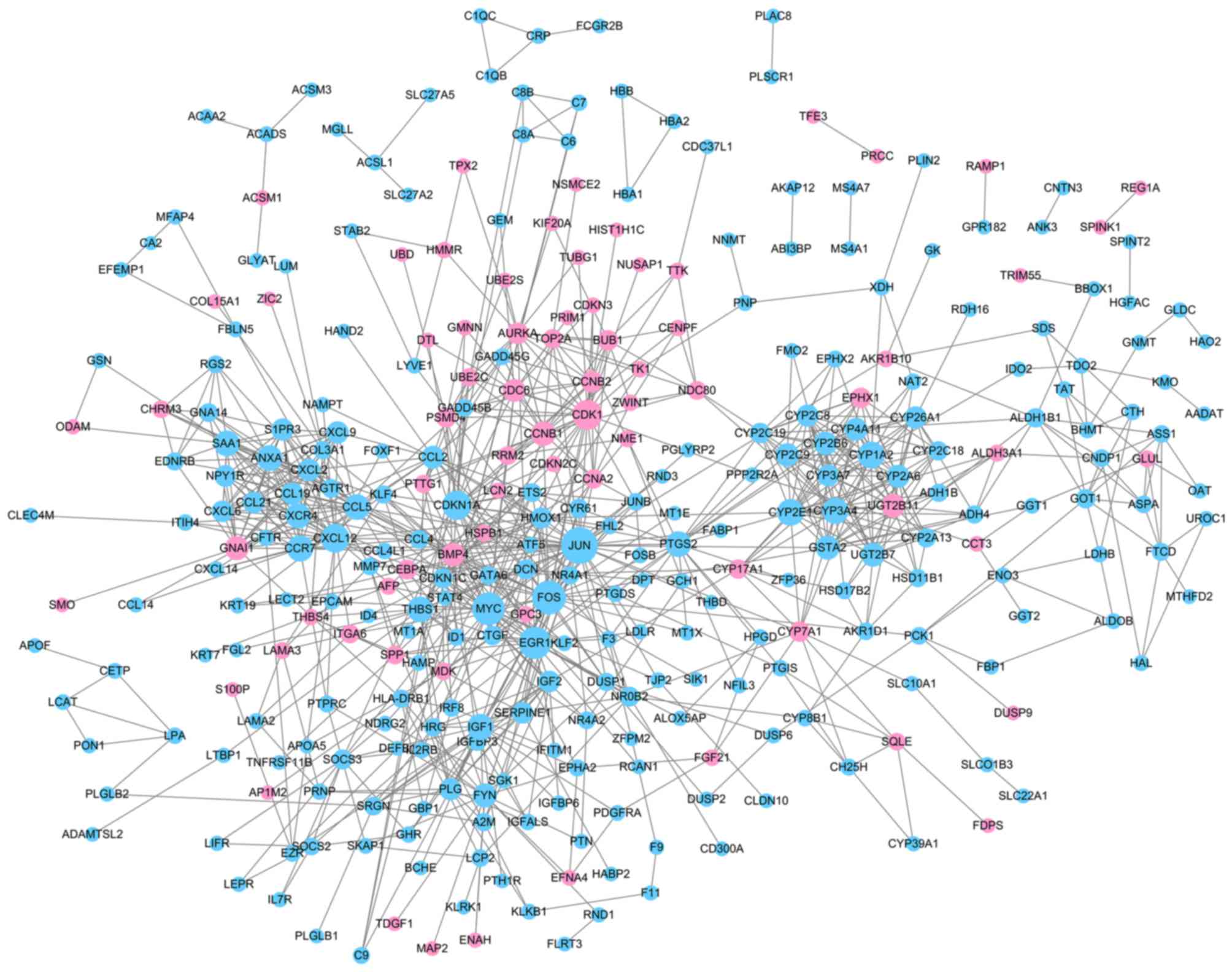|
1
|
Siegel RL, Miller KD and Jemal A: Cancer
statistics, 2016. CA Cancer J Clin. 66:7–30. 2016. View Article : Google Scholar : PubMed/NCBI
|
|
2
|
Fan Q, He M, Deng X, Wu WK, Zhao L, Tang
J, Wen G, Sun X and Liu Y: Derepression of c-Fos caused by
microRNA-139 down-regulation contributes to the metastasis of human
hepatocellular carcinoma. Cell Biochem Funct. 31:319–324. 2013.
View Article : Google Scholar : PubMed/NCBI
|
|
3
|
Archambeaud I, Auble H, Nahon P, Planche
L, Fallot G, Faroux R, Gournay J, Samuel D, Kury S and Féray C:
Risk factors for hepatocellular carcinoma in caucasian patients
with non-viral cirrhosis: The importance of prior obesity. Liver
Int. 35:1872–1876. 2015. View Article : Google Scholar : PubMed/NCBI
|
|
4
|
Saunders D, Seidel D, Allison M and
Lyratzopoulos G: Systematic review: The association between obesity
and hepatocellular carcinoma-epidemiological evidence. Aliment
Pharmacol Ther. 31:1051–1063. 2010.PubMed/NCBI
|
|
5
|
Naveau S: Body mass index and risk of
liver cirrhosis in middle aged UK women: prospective study.
Gastroentérol Clin Biol. 34:429–430. 2010. View Article : Google Scholar
|
|
6
|
Zhang DY and Friedman SL:
Fibrosis-dependent mechanisms of hepatocarcinogenesis. Hepatology.
56:769–775. 2012. View Article : Google Scholar : PubMed/NCBI
|
|
7
|
Su TH, Kao JH and Liu CJ: Molecular
mechanism and treatment of viral hepatitis-related liver fibrosis.
Int J Mol Sci. 15:10578–10604. 2014. View Article : Google Scholar : PubMed/NCBI
|
|
8
|
Friedman SL: Hepatic stellate cells:
Protean, multifunctional, and enigmatic cells of the liver. Physiol
Rev. 88:125–172. 2008. View Article : Google Scholar : PubMed/NCBI
|
|
9
|
De Minicis S, Seki E, Uchinami H, Kluwe J,
Zhang Y, Brenner DA and Schwabe RF: Gene expression profiles during
hepatic stellate cell activation in culture and in vivo.
Gastroenterology. 132:1937–1946. 2007. View Article : Google Scholar : PubMed/NCBI
|
|
10
|
Liu WT, Jing YY, Yu GF, Han ZP, Yu DD, Fan
QM, Ye F, Li R, Gao L, Zhao QD, et al: Toll like receptor 4
facilitates invasion and migration as a cancer stem cell marker in
hepatocellular carcinoma. Cancer Lett. 358:136–143. 2014.
View Article : Google Scholar : PubMed/NCBI
|
|
11
|
Lee SK, Kim MH, Cheong JY, Cho SW, Yang SJ
and Kwack K: Integrin alpha V polymorphisms and haplotypes in a
Korean population are associated with susceptibility to chronic
hepatitis and hepatocellular carcinoma. Liver Int. 29:187–195.
2009. View Article : Google Scholar : PubMed/NCBI
|
|
12
|
Fu BH, Wu ZZ and Qin J: Effects of
integrins on laminin chemotaxis by hepatocellular carcinoma cells.
Mol Biol Rep. 37:1665–1670. 2010. View Article : Google Scholar : PubMed/NCBI
|
|
13
|
Vlodavsky I, Miao HQ, Medalion B, Danagher
P and Ron D: Involvement of heparan sulfate and related molecules
in sequestration and growth promoting activity of fibroblast growth
factor. Cancer Metastasis Rev. 15:177–186. 1996. View Article : Google Scholar : PubMed/NCBI
|
|
14
|
Villanueva A, Portela A, Sayols S,
Battiston C, Hoshida Y, Méndez-González J, Imbeaud S, Letouzé E,
Hernandez-Gea V, Cornella H, et al: DNA methylation-based prognosis
and epidrivers in hepatocellular carcinoma. Hepatology.
61:1945–1956. 2015. View Article : Google Scholar : PubMed/NCBI
|
|
15
|
Bolstad BM, Irizarry RA, Astrand M and
Speed TP: A comparison of normalization methods for high density
oligonucleotide array data based on variance and bias.
Bioinformatics. 19:185–193. 2003. View Article : Google Scholar : PubMed/NCBI
|
|
16
|
Irizarry RA, Hobbs B, Collin F,
Beazer-Barclay YD, Antonellis KJ, Scherf U and Speed TP:
Exploration, normalization, and summaries of high density
oligonucleotide array probe level data. Biostatistics. 4:249–264.
2003. View Article : Google Scholar : PubMed/NCBI
|
|
17
|
Gautier L, Cope L, Bolstad BM and Irizarry
RA: Affy-analysis of Affymetrix GeneChip data at the probe level.
Bioinformatics. 20:307–315. 2004. View Article : Google Scholar : PubMed/NCBI
|
|
18
|
Smyth GK: limma: Linear models for
microarray data. Springer; New York: pp. 397–420. 2005
|
|
19
|
Benjamini Y and Hochberg Y: Controlling
the false discovery rate: A practical and powerful approach to
multiple testing. J R Stat Soc. 57:289–300. 1995.
|
|
20
|
Ashburner M, Ball CA, Blake JA, Botstein
D, Butler H, Cherry JM, Davis AP, Dolinski K, Dwight SS, Eppig JT,
et al: Gene ontology: Tool for the unification of biology. The gene
ontology consortium. Nat Genet. 25:25–29. 2000. View Article : Google Scholar : PubMed/NCBI
|
|
21
|
Kanehisa M and Goto S: KEGG: Κyoto
encyclopedia of genes and genomes. Nucleic Acids Res. 28:27–30.
2000. View Article : Google Scholar : PubMed/NCBI
|
|
22
|
Huang DW, Sherman BT, Tan Q, Collins JR,
Alvord WG, Roayaei J, Stephens R, Baseler MW, Lane HC and Lempicki
RA: The DAVID gene functional classification tool: A novel
biological module-centric algorithm to functionally analyze large
gene lists. Genome Biol. 8:R1832007. View Article : Google Scholar : PubMed/NCBI
|
|
23
|
von Mering C, Huynen M, Jaeggi D, Schmidt
S, Bork P and Snel B: STRING: A database of predicted functional
associations between proteins. Nucleic Acids Res. 31:258–261. 2003.
View Article : Google Scholar : PubMed/NCBI
|
|
24
|
Shannon P, Markiel A, Ozier O, Baliga NS,
Wang JT, Ramage D, Amin N, Schwikowski B and Ideker T: Cytoscape: A
software environment for integrated models of biomolecular
interaction networks. Genome Res. 13:2498–2504. 2003. View Article : Google Scholar : PubMed/NCBI
|
|
25
|
Tang Y, Li M, Wang J, Pan Y and Wu FX:
CytoNCA: A cytoscape plugin for centrality analysis and evaluation
of protein interaction networks. Biosystems. 127:67–72. 2015.
View Article : Google Scholar : PubMed/NCBI
|
|
26
|
He X and Zhang J: Why do hubs tend to be
essential in protein networks? PLoS Genet. 2:e882006. View Article : Google Scholar : PubMed/NCBI
|
|
27
|
Bader GD and Hogue CW: An automated method
for finding molecular complexes in large protein interaction
networks. BMC Bioinformatics. 4:22003. View Article : Google Scholar : PubMed/NCBI
|
|
28
|
Ehling J and Tacke F: Role of chemokine
pathways in hepatobiliary cancer. Cancer Lett. 379:173–183. 2015.
View Article : Google Scholar : PubMed/NCBI
|
|
29
|
Charo IF and Ransohoff RM: The many roles
of chemokines and chemokine receptors in inflammation. N Engl J
Med. 354:610–621. 2006. View Article : Google Scholar : PubMed/NCBI
|
|
30
|
Marra F and Tacke F: Roles for chemokines
in liver disease. Gastroenterology. 147:577–594.e1. 2014.
View Article : Google Scholar : PubMed/NCBI
|
|
31
|
Wald O, Pappo O, Safadi R, Dagan-Berger M,
Beider K, Wald H, Franitza S, Weiss I, Avniel S, Boaz P, et al:
Involvement of the CXCL12/CXCR4 pathway in the advanced liver
disease that is associated with hepatitis C virus or hepatitis B
virus. Eur J Immunol. 34:1164–1174. 2004. View Article : Google Scholar : PubMed/NCBI
|
|
32
|
Ghanem I, Riveiro ME, Paradis V, Faivre S,
de Parga PM and Raymond E: Insights on the CXCL12-CXCR4 axis in
hepatocellular carcinoma carcinogenesis. Am J Transl Res.
6:340–352. 2014.PubMed/NCBI
|
|
33
|
Schimanski CC, Bahre R, Gockel I, Müller
A, Frerichs K, Hörner V, Teufel A, Simiantonaki N, Biesterfeld S,
Wehler T, et al: Dissemination of hepatocellular carcinoma is
mediated via chemokine receptor CXCR4. Br J Cancer. 95:210–217.
2006. View Article : Google Scholar : PubMed/NCBI
|
|
34
|
Shah AD, Bouchard MJ and Shieh AC:
Interstitial fluid flow increases hepatocellular carcinoma cell
invasion through CXCR4/CXCL12 and MEK/ERK signaling. PLoS One.
10:e01423372015. View Article : Google Scholar : PubMed/NCBI
|
|
35
|
Xiang ZL, Zeng ZC, Tang ZY, Fan J, Zhuang
PY, Liang Y, Tan YS and He J: Chemokine receptor CXCR4 expression
in hepatocellular carcinoma patients increases the risk of bone
metastases and poor survival. BMC Cancer. 9:1762009. View Article : Google Scholar : PubMed/NCBI
|
|
36
|
Neve Polimeno M, Ierano C, D'Alterio C,
Simona Losito N, Napolitano M, Portella L, Scognamiglio G,
Tatangelo F, Maria Trotta A, Curley S, et al: CXCR4 expression
affects overall survival of HCC patients whereas CXCR7 expression
does not. Cell Mol Immunol. 12:474–482. 2015. View Article : Google Scholar : PubMed/NCBI
|
|
37
|
Shibuta K, Mori M, Shimoda K, Inoue H,
Mitra P and Barnard GF: Regional expression of CXCL12/CXCR4 in
liver and hepatocellular carcinoma and cell-cycle variation during
in vitro differentiation. Jpn J Cancer Res. 93:789–797. 2002.
View Article : Google Scholar : PubMed/NCBI
|
|
38
|
Schimanski CC, Bahre R, Gockel I,
Junginger T, Simiantonaki N, Biesterfeld S, Achenbach T, Wehler T,
Galle PR and Moehler M: Chemokine receptor CCR7 enhances
intrahepatic and lymphatic dissemination of human hepatocellular
cancer. Oncol Rep. 16:109–113. 2006.PubMed/NCBI
|
|
39
|
Luo KQ, Shi YN and Peng JC: The effect of
chemokine CC motif ligand 19 on the proliferation and migration of
hepatocellular carcinoma. Tumour Biol. 35:12575–12581. 2014.
View Article : Google Scholar : PubMed/NCBI
|
|
40
|
Shi JY, Yang LX, Wang ZC, Wang LY, Zhou J,
Wang XY, Shi GM, Ding ZB, Ke AW, Dai Z, et al: CC chemokine
receptor like 1 functions as a tumor suppressor by impairing
CCR7-related chemotaxis in hepatocellular carcinoma. J Pathol.
235:546–558. 2015. View Article : Google Scholar : PubMed/NCBI
|
|
41
|
Heinzel K, Benz C and Bleul CC: A silent
chemokine receptor regulates steady-state leukocyte homing in vivo.
Proc Natl Acad Sci USA. 104:pp. 8421–8426. 2007; View Article : Google Scholar : PubMed/NCBI
|
|
42
|
Liang CM, Chen L, Hu H, Ma HY, Gao LL, Qin
J and Zhong CP: Chemokines and their receptors play important roles
in the development of hepatocellular carcinoma. World J Hepatol.
7:1390–1402. 2015. View Article : Google Scholar : PubMed/NCBI
|
|
43
|
Mohs A, Kuttkat N, Reißing J, Zimmermann
HW, Sonntag R, Proudfoot A, Youssef SA, de Bruin A4, Cubero FJ and
Trautwein C: Functional role of CCL5/RANTES for HCC progression
during chronic liver disease. J Hepatol. 66:743–753. 2017.
View Article : Google Scholar : PubMed/NCBI
|
|
44
|
Bai H, Weng Y, Bai S, Jiang Y, Li B, He F,
Zhang R, Yan S, Deng F, Wang J and Shi Q: CCL5 secreted from bone
marrow stromal cells stimulates the migration and invasion of Huh7
hepatocellular carcinoma cells via the PI3K-Akt pathway. Int J
Oncol. 45:333–343. 2014. View Article : Google Scholar : PubMed/NCBI
|
|
45
|
Sadeghi M, Lahdou I, Oweira H, Daniel V,
Terness P, Schmidt J, Weiss KH, Longerich T, Schemmer P, Opelz G
and Mehrabi A: Serum levels of chemokines CCL4 and CCL5 in
cirrhotic patients indicate the presence of hepatocellular
carcinoma. Br J Cancer. 113:756–762. 2015. View Article : Google Scholar : PubMed/NCBI
|
|
46
|
Korobkova EA: Effect of natural
polyphenols on CYP metabolism: implications for diseases. Chem Res
Toxicol. 28:1359–1390. 2015. View Article : Google Scholar : PubMed/NCBI
|
|
47
|
Puszyk WM, Hlady R, Robertson K, Cabrera R
and Liu C: Epigenetic signatures of alcohol abuse in hepatocellular
carcinoma. FASEB J. 30 1 Suppl:S516.112016.
|
|
48
|
Kinoshita M and Miyata M: Underexpression
of mRNA in human hepatocellular carcinoma focusing on eight loci.
Hepatology. 36:433–438. 2002. View Article : Google Scholar : PubMed/NCBI
|
|
49
|
Wu X, Li C, Xing G, Qi X and Ren J:
Resveratrol downregulates Cyp2e1 and attenuates chemically induced
hepatocarcinogenesis in SD rats. J Toxicol Pathol. 26:385–392.
2013. View Article : Google Scholar : PubMed/NCBI
|
|
50
|
Chen H, Shen ZY, Xu W, Fan TY, Li J, Lu
YF, Cheng ML and Liu J: Expression of P450 and nuclear receptors in
normal and end-stage Chinese livers. World J Gastroenterol.
20:8681–8690. 2014. View Article : Google Scholar : PubMed/NCBI
|
|
51
|
Yu D, Green B, Marrone A, Guo Y, Kadlubar
S, Lin D, Fuscoe J, Pogribny I and Ning B: Suppression of CYP2C9 by
microRNA hsa-miR-128-3p in human liver cells and association with
hepatocellular carcinoma. Sci Rep. 5:85342015. View Article : Google Scholar : PubMed/NCBI
|
|
52
|
Myung SJ, Yoon JH and Yu SJ: STAT3 &
Cytochrome P450 2C9: A novel signaling pathway in liver cancer stem
cells. Biomed Pharmacother. 66:612–616. 2012. View Article : Google Scholar : PubMed/NCBI
|
|
53
|
Jover R, Bort R, Gómez-Lechón MJ and
Castell JV: Cytochrome P450 regulation by hepatocyte nuclear factor
4 in human hepatocytes: A study using adenovirus-mediated antisense
targeting. Hepatology. 33:668–675. 2001. View Article : Google Scholar : PubMed/NCBI
|
|
54
|
Fushiya N, Takagi I, Nishino H, Akizuki S
and Ohnishi A: Genetic polymorphisms of enzymes related to oral
tegafur/uracil therapeutic efficacy in patients with hepatocellular
carcinoma. Anticancer Drugs. 24:617–622. 2013.PubMed/NCBI
|
|
55
|
Iizuka N, Oka M, Hamamoto Y, Mori N,
Tamesa T, Tangoku A, Miyamoto T, Uchimura S, Tamesa T, Tangoku A,
et al: Altered levels of cytochrome p450 genes in hepatitis B or C
virus-infected liver identified by oligonucleotide microarray.
Cancer Genomics Proteomics. 1:53–58. 2004.
|
|
56
|
Sotaniemi EA, Rautio A, Bäckstrom M,
Arvela P and Pelkonen O: CYP3A4 and CYP2A6 activities marked by the
metabolism of lignocaine and coumarin in patients with liver and
kidney diseases and epileptic patients. Br J Clin Pharmacol.
39:71–76. 1995. View Article : Google Scholar : PubMed/NCBI
|


















